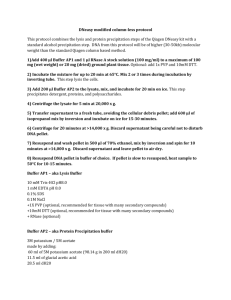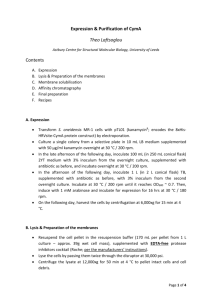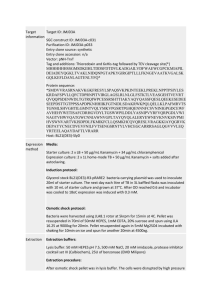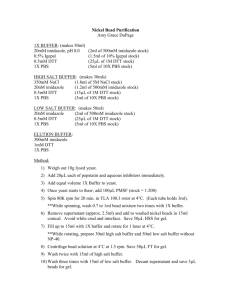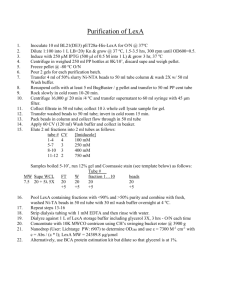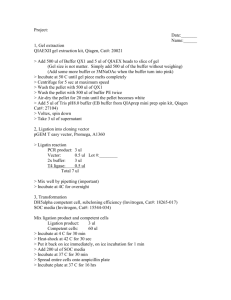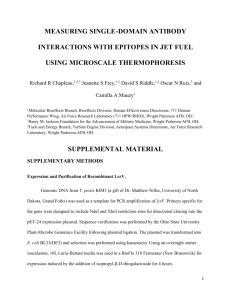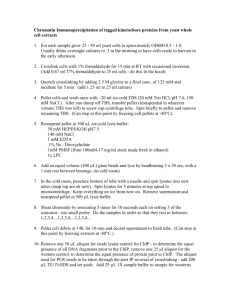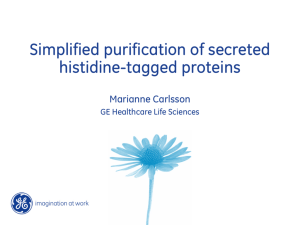word
advertisement
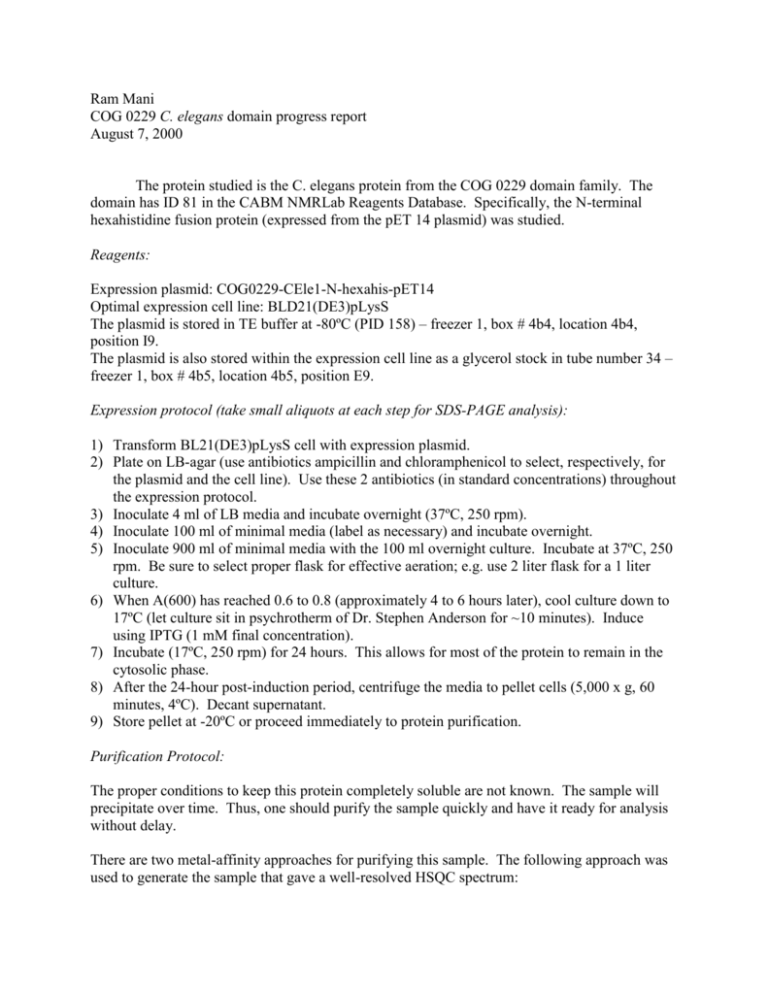
Ram Mani COG 0229 C. elegans domain progress report August 7, 2000 The protein studied is the C. elegans protein from the COG 0229 domain family. The domain has ID 81 in the CABM NMRLab Reagents Database. Specifically, the N-terminal hexahistidine fusion protein (expressed from the pET 14 plasmid) was studied. Reagents: Expression plasmid: COG0229-CEle1-N-hexahis-pET14 Optimal expression cell line: BLD21(DE3)pLysS The plasmid is stored in TE buffer at -80ºC (PID 158) – freezer 1, box # 4b4, location 4b4, position I9. The plasmid is also stored within the expression cell line as a glycerol stock in tube number 34 – freezer 1, box # 4b5, location 4b5, position E9. Expression protocol (take small aliquots at each step for SDS-PAGE analysis): 1) Transform BL21(DE3)pLysS cell with expression plasmid. 2) Plate on LB-agar (use antibiotics ampicillin and chloramphenicol to select, respectively, for the plasmid and the cell line). Use these 2 antibiotics (in standard concentrations) throughout the expression protocol. 3) Inoculate 4 ml of LB media and incubate overnight (37ºC, 250 rpm). 4) Inoculate 100 ml of minimal media (label as necessary) and incubate overnight. 5) Inoculate 900 ml of minimal media with the 100 ml overnight culture. Incubate at 37ºC, 250 rpm. Be sure to select proper flask for effective aeration; e.g. use 2 liter flask for a 1 liter culture. 6) When A(600) has reached 0.6 to 0.8 (approximately 4 to 6 hours later), cool culture down to 17ºC (let culture sit in psychrotherm of Dr. Stephen Anderson for ~10 minutes). Induce using IPTG (1 mM final concentration). 7) Incubate (17ºC, 250 rpm) for 24 hours. This allows for most of the protein to remain in the cytosolic phase. 8) After the 24-hour post-induction period, centrifuge the media to pellet cells (5,000 x g, 60 minutes, 4ºC). Decant supernatant. 9) Store pellet at -20ºC or proceed immediately to protein purification. Purification Protocol: The proper conditions to keep this protein completely soluble are not known. The sample will precipitate over time. Thus, one should purify the sample quickly and have it ready for analysis without delay. There are two metal-affinity approaches for purifying this sample. The following approach was used to generate the sample that gave a well-resolved HSQC spectrum: Cell Lysis & Metal-Affinity Purification 1) Resuspend the cell pellet (in this case, the pellet came from 750 ml of culture) in 75 ml (1:10 culture: resuspension) of lysis/extraction buffer (50 mM NaPi, 300 mM NaCl, 5 mM imidazole, pH 8.0). 2) Sonicate for 20 minutes (ON time) at setting 4 in cycles of 30 seconds ON and 30 seconds OFF. Keep sample in a 4C ice-water bath with stir bar. 3) Spin down cell debris (75 minutes, 20,000 x g, 4C). You will purify the supernatant. 4) Prepare a nickel-NTA column by adding 4 ml of resin and equilibrating using lysis/extraction buffer. 5) After centrifugation, filter sample (supernatant) using 0.45 um filter and syringe. 6) Pour sample through column. Save flowthru. 7) Wash column (50 mM NaPi, 300 mM NaCl, 10 mM imidazole, pH 8.0) until A(280) of last ml of wash flowthru is less than 0.05 (~50 ml). 8) Wash column (50 mM NaPi, 300 mM NaCl, 20 mM imidazole, pH 8.0) until A(280) of last ml of wash flowthru is less than 0.01 (~20 ml). 9) Elute sample using 25 ml of elution buffer (50 mM NaPi, 300 mM NaCl, 250 mM imidazole, pH 8.0) and collect as 1 ml fractions. 10) Quickly estimate concentration of target protein in elution fractions by measuring A(280) of each fraction. Elute more if necessary. 11) Raise each of the elution fractions to 2 mM EDTA, wait 2 minutes, and then raise each fraction to 10 mM DTT. Dialysis 1) Pool together elution fractions that contain target protein. 2) Dialyze in 50 mM NaPi, 200 mM NaCl, 10 mM DTT, pH 6.5 (use buffer at least 50x in volume; refresh buffer twice) for 12 to 16 hours. 3) Recover sample. You will see precipitate because isoelectric point (pI = 7.70) was approached during dialysis. A(280) reduced during dialysis from 2.3 to 1.7. Gel Filtration 1) The sample needs to be concentrated to perform gel filtration efficiently and effectively. Because a 2 ml FPLC loop will be used, one gel filtration run will have to be performed for every 2 ml of final sample volume. 2) Before concentrating via centrifugal filtering, sample should be filtered using 0.45 um filter and syringe. This is to avoid precipitation during concentrating. 3) Concentrate using Centriplus (YM-3) and Centricon (YM-3). Be sure to prerinse/equilibrate centrifugal devices. 4) Perform gel filtration on Pharmacia’s Superdex 75 prep grade column (in our lab, labeled Albert’s column) using the following buffer: 50 mM NaPi, 200 mM NaCl, 10 mM DTT, pH 6.5. Flow rate is 0.9 ml/min, fraction size is 1 ml, and collect from 7.5 to 17.5 ml. The sample should elute in ~4 ml centered around 12.5 ml. You can now concentrate this sample and take an HSQC. At 0.03 mM protein concentration, the sample gave good spectra after a long experiment. After dialysis into a 50 mM MES, 200 mM NaCl, 10 mM DTT, pH 6.5 buffer, the sample also gave good and stronger spectra at 0.3 mM protein concentration. Alternative Purification Strategy: One can purify the protein at pH 7.0 to avoid having to dialyze across the pI. When purifying in such conditions, do not use imidazole in the lysis/extraction buffer. The TALON cobalt-bound resin performs well during these conditions. Follow the instructions in the manual, except use elution buffer of pH 6.5 and 250 mM imidazole concentration. Comments on Protein Precipitation Problem: The protein gradually precipitates in buffers with 200 to 300 mM NaCl, 50 mM NaPi, 50 mM MES, pH 5.5 to 8.3, 10-15 mM DTT. If no DTT is added, the protein will surely precipitate, presumably because of improper disulfide bond formation among its 8 cysteines. I was not able to resolubilize the precipitate using the above-mentioned buffers. The Hampton X-crystallography catalog may provide useful suggestions for alternative buffers to improve solubility.

